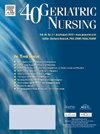Advanced age, tobacco use, insufficient physical activity, and high sedentary behavior associated with lower limb muscle weakness in older adults: A cross-sectional study
IF 2.4
3区 医学
Q3 GERIATRICS & GERONTOLOGY
引用次数: 0
Abstract
Objective
To investigate the factors associated with lower limb (LL) muscle weakness in older adults residing in a small municipality in Northeastern Brazil. Methods: This population-based, cross-sectional epidemiological study included 194 older adults. Independent variables included socioeconomic, behavioral, and health-related factors. The outcome was defined by poor performance on the 30-second chair stand test. Poisson regression with robust variance was used to estimate Prevalence Ratios (PR) and corresponding 95 % Confidence Intervals (CI). Results: The prevalence of LL muscle weakness was 30.40 %. A higher probability of LL muscle weakness was observed among individuals of advanced age (PR: 1.05; 95 % CI: 1.021.07), those who reported smoking (PR: 2.31; 95 % CI: 1.23–4.42), were insufficiently active (PR: 1.98; 95 % CI: 1.13–3.46), or exhibited high sedentary behavior (PR: 1.72; 95 % CI: 1.08–2.72). Conclusion: Advanced age, insufficient physical activity, high sedentary behavior, and tobacco use were positively associated with LL muscle weakness in the study population.
高龄、吸烟、体力活动不足和久坐行为与老年人下肢肌肉无力相关:一项横断面研究
目的探讨巴西东北部一个小城市老年人下肢肌无力的相关因素。方法:这项以人群为基础的横断面流行病学研究包括194名老年人。独立变量包括社会经济、行为和健康相关因素。结果是在30秒的椅架测试中表现不佳。采用稳健方差的泊松回归来估计患病率(PR)和相应的95%置信区间(CI)。结果:腰系肌无力患病率为30.40%。老年个体中LL肌无力的概率更高(PR: 1.05;95% CI: 1.021.07),报告吸烟的人(PR: 2.31;95% CI: 1.23-4.42),活动不足(PR: 1.98;95% CI: 1.13-3.46),或表现出高久坐行为(PR: 1.72;95% ci: 1.08-2.72)。结论:在研究人群中,高龄、体力活动不足、久坐行为和吸烟与LL肌无力呈正相关。
本文章由计算机程序翻译,如有差异,请以英文原文为准。
求助全文
约1分钟内获得全文
求助全文
来源期刊

Geriatric Nursing
医学-护理
CiteScore
3.80
自引率
7.40%
发文量
257
审稿时长
>12 weeks
期刊介绍:
Geriatric Nursing is a comprehensive source for clinical information and management advice relating to the care of older adults. The journal''s peer-reviewed articles report the latest developments in the management of acute and chronic disorders and provide practical advice on care of older adults across the long term continuum. Geriatric Nursing addresses current issues related to drugs, advance directives, staff development and management, legal issues, client and caregiver education, infection control, and other topics. The journal is written specifically for nurses and nurse practitioners who work with older adults in any care setting.
 求助内容:
求助内容: 应助结果提醒方式:
应助结果提醒方式:


